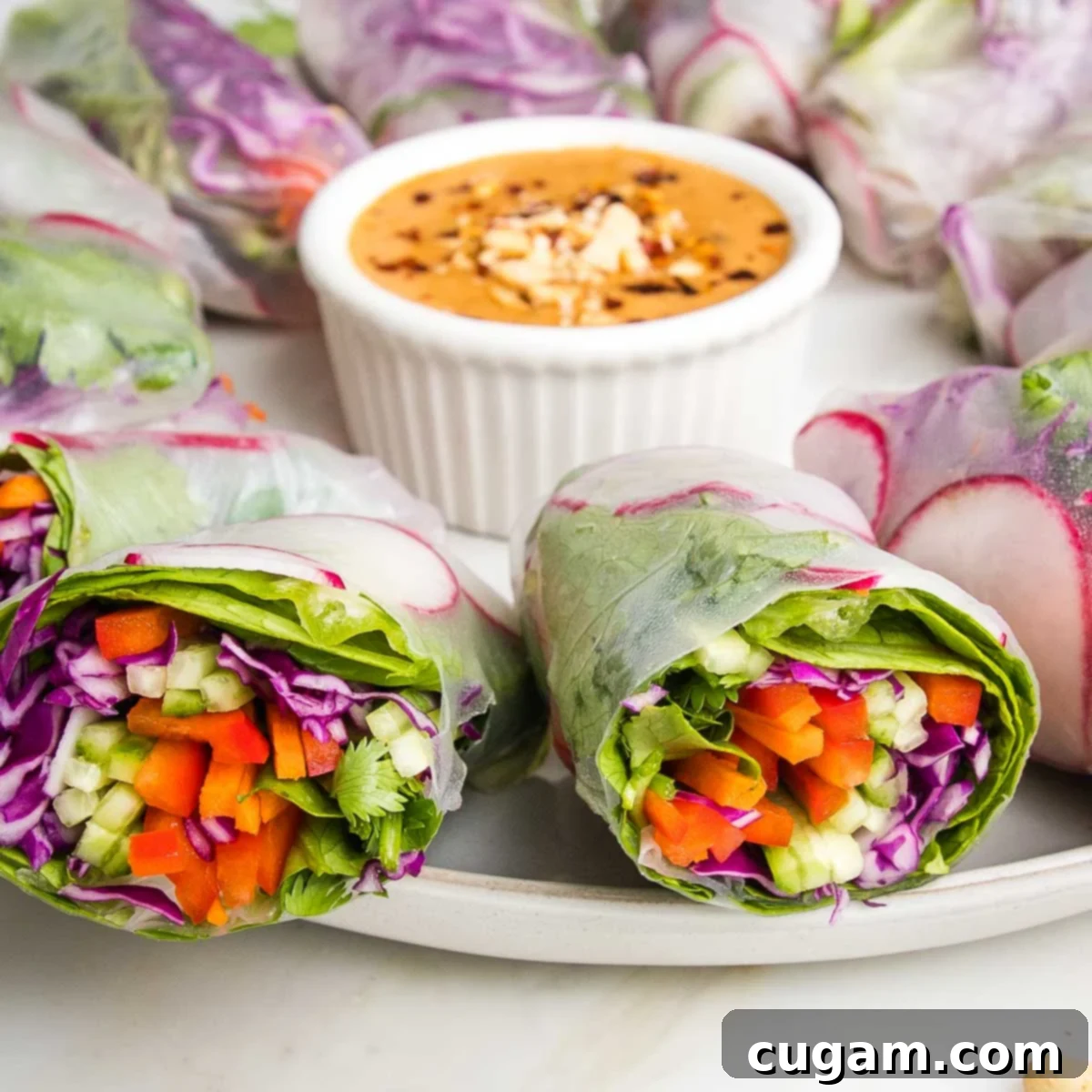Easy Vegan & Gluten-Free Fresh Spring Rolls with Irresistible Peanut Dipping Sauce
Craving a light, refreshing, and incredibly satisfying dish that’s also bursting with flavor? Look no further than these **Homemade Vegetable Spring Rolls**! They’re far easier to make than you might imagine, and I’m here to guide you through every step. You’ll learn how to perfectly prepare a medley of fresh, crunchy vegetables, skillfully load them into delicate rice paper wrappers, and whip up a divinely simple homemade peanut dipping sauce that will become your new obsession. These beautiful, fresh rolls are naturally vegan and gluten-free, making them a crowd-pleasing appetizer or a wholesome main course that everyone can enjoy.
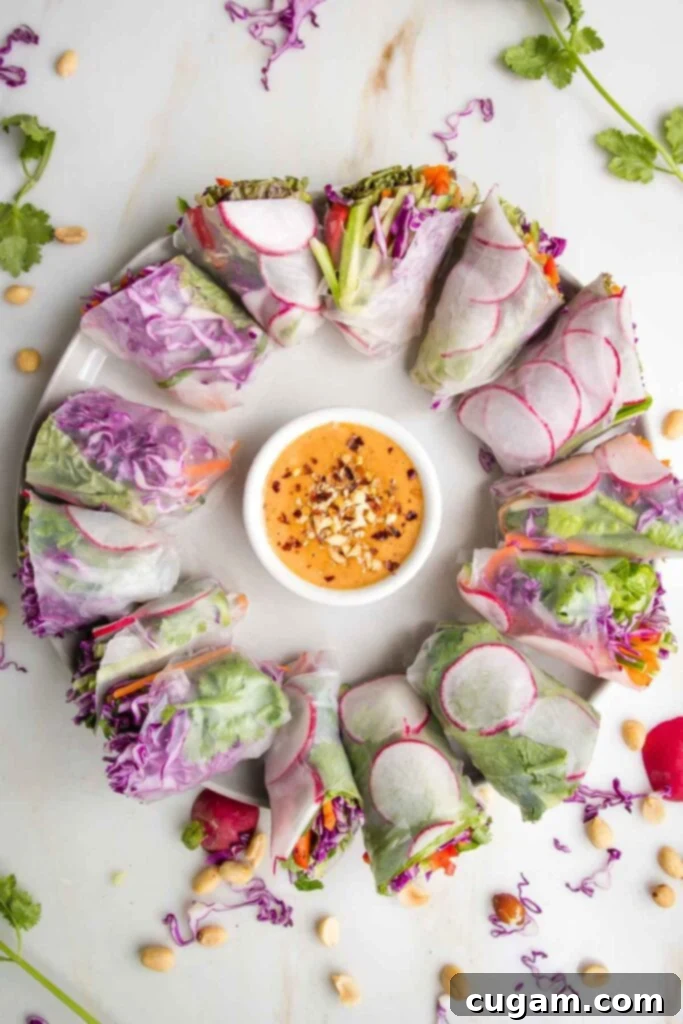
This post has been modified and updated for clarity and additional tips from the original content posted on August 20, 2016.
This easy spring rolls recipe offers a delightful combination of cool, refreshing textures and flavors, making it perfectly light yet incredibly satisfying. The key to their delicate nature lies in the translucent rice paper wrappers, which are briefly softened in water before being generously filled with an assortment of your favorite crisp, vibrant vegetables. But let’s be honest, while the rolls themselves are fantastic, it’s that homemade peanut dipping sauce that truly steals the show. Trust me, it’s unbelievably good!
Seriously, it’s insanely delicious. A word of **CAUTION**: you’ll find yourself wanting to drizzle this luscious peanut butter sauce on absolutely everything – and don’t be surprised if someone at the table asks for a spoon to enjoy it straight from the bowl! Its rich, creamy texture and balanced flavors are simply addictive.
While the peanut sauce is a star, these versatile fresh rolls can be dipped in a variety of other sauces too. For a taste of summer, try them with my favorite mango dressing, transforming them into vibrant summer rolls. You can easily vary the filling ingredients with seasonal produce, making them perfect for spring or fall, and simply call them fresh rolls. And in the depths of winter, don’t hesitate to grab some hoisin sauce straight from the bottle – it’s a perfectly legitimate and delicious dip for these beauties! Ultimately, “salad rolls” is a truly accurate description, as they pack all the goodness of a salad into a neat, dippable package. So, whether you call them spring rolls, summer rolls, or salad rolls, you do you!
Selecting the Best Vegetables for Fresh Spring Rolls
My guiding principle when choosing filling ingredients for these fresh spring rolls is simple: make them fresh, colorful, and crunchy! Any combination of your favorite crisp vegetables will work wonderfully, offering a beautiful mosaic of flavors and textures in every bite. Here are some of my top recommendations:
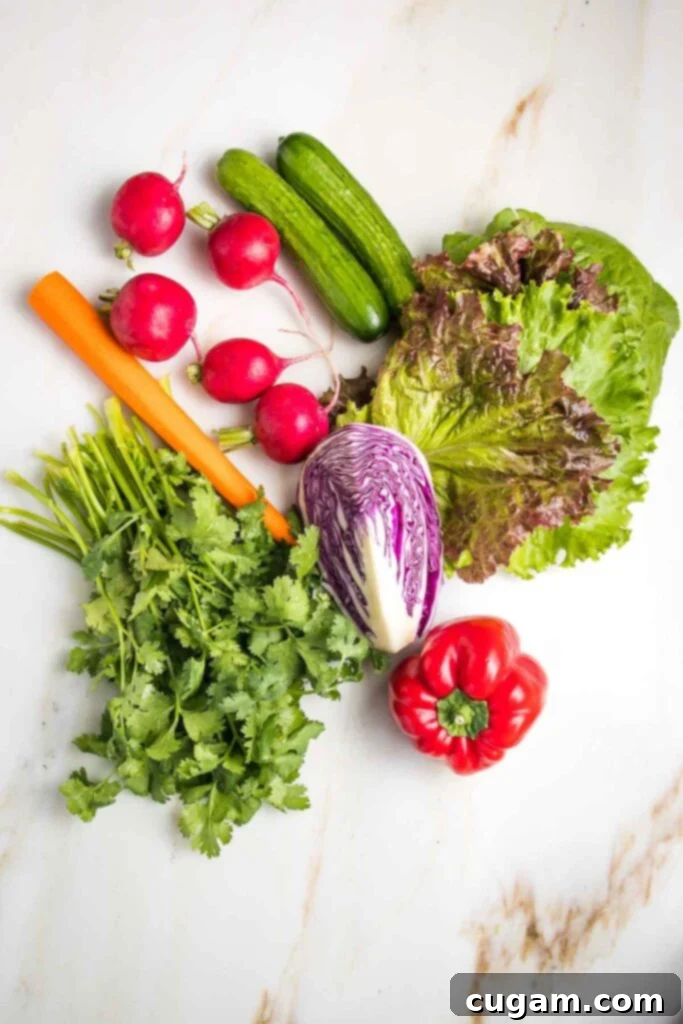
- Purple Cabbage: I absolutely adore the striking pop of color that thinly shredded purple cabbage brings to these rolls. Beyond its visual appeal, it offers a fantastic crunch, is incredibly easy to work with, and is packed with essential nutrients, making it a healthy and delicious choice.
- Red Bell Pepper: Sliced thinly, red bell peppers add a sweet, vibrant flavor and a satisfying crispness. They are an excellent source of vitamins A and C, contributing both flavor and a nutritional boost to your fresh rolls.
- Carrot: Shredded or julienned carrot is another fantastic ingredient that adds a beautiful orange hue and a touch of sweetness. Carrots are not only inexpensive and easy to prepare, but they are also rich in beta-carotene and other vital nutrients.
- Fresh Cilantro: If you’ve been following my recipes, you know my deep affection for fresh herbs, and cilantro holds a special place. Its bright, citrusy notes are perfect for balancing the richness of the peanut sauce. If cilantro isn’t to your taste (some people find it tastes like soap!), feel free to substitute with another fresh herb like parsley or Thai basil for an equally superb summer roll experience.
- Persian Cucumber: I prefer Persian cucumbers for their thinner, more tender skin, but any cucumber variety will contribute a wonderful refreshing crunch and essential moisture to your fresh rolls. They are a must-have for a crisp texture.
- Radish: Don’t underestimate the humble radish! Thinly sliced radishes provide a delightful, peppery kick without being overtly spicy, adding an exciting dimension to the flavor profile. For an extra touch of visual appeal, try arranging a neat row of these thinly sliced radishes against the edge of your wrapper – it looks super pretty and fun!
- Lettuce Leaves: Who says leafy greens are only for salads? A crisp lettuce leaf, such as romaine or red leaf lettuce, acts as an excellent base within the roll, helping to hold all the other ingredients in place. Beyond its structural role, lettuce adds extra crunch, a refreshing green color, and is loaded with fat-soluble vitamins, which will be more readily absorbed when paired with that delicious peanut sauce.
- OTHER VEGGIES & FILLINGS: The possibilities are truly endless! Feel free to use any vegetables you have on hand or absolutely love. Consider adding slices of al dente baked sweet potatoes or rice noodles to create more substantial filling spring rolls that can easily be served as a light dinner. Creamy avocado slices add a luxurious texture, while a smear of pesto offers a unique flavor twist. Other fantastic crunchy options include snow peas, daikon radish, or fresh bean sprouts. For an extra flavor boost, try thinly sliced fennel or scallions. The best choices are always whatever is in season and easily accessible to you, encouraging creativity and fresh flavors.
The Art of Mise en Place: Preparing for Spring Roll Success
“Mise en place” is a French culinary term that means “everything in its place.” For fresh spring rolls, this concept is absolutely crucial. Having all your ingredients prepped, chopped, and neatly arranged before you begin rolling will transform the process from potentially stressful to quick, easy, and enjoyable. Once your filling ingredients are prepared, making these fresh rolls is a breeze.
To keep your prepped ingredients fresh, especially if you’re preparing them a bit in advance, cover them with damp paper towels and store them in the fridge until you’re ready to roll. This is a critical step because working with rice paper wrappers requires precise timing. There’s a fine line between a wrapper that hasn’t soaked enough (resulting in a stiff, unpliable sheet) and one that waited too long to be rolled and has become a sticky, clingy mess. When it’s “go time,” you’ll want everything at your fingertips to ensure a smooth, efficient rolling experience.
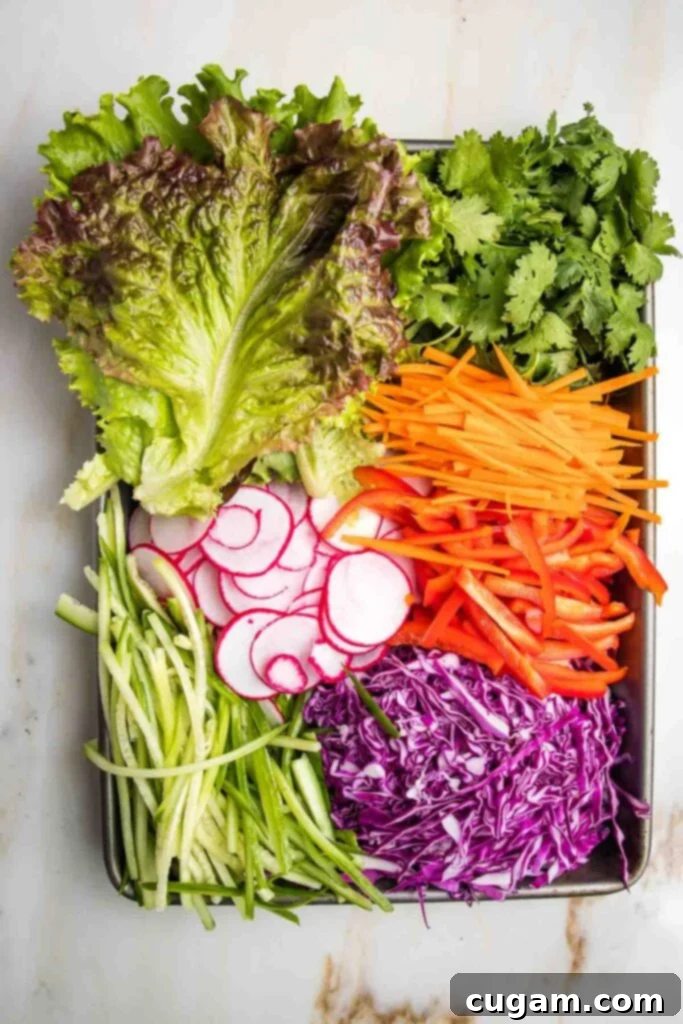
The term “julienne” describes cutting vegetables into long, thin strips, resembling matchsticks. Filling your spring rolls with julienned veggies makes them significantly easier to roll tightly and neatly, ensuring a compact and appealing presentation.
For quick and consistent julienning, I find my mandolin to be an invaluable tool. You can also find inexpensive handheld mandolins that work just as well for smaller tasks. Whichever tool you choose, **always remember to wear a cut-resistant glove to protect your hands** – safety first! Alternatively, a sharp chef’s knife and a sturdy cutting board will also yield excellent results, as will a simple julienne peeler.
Essential Ingredients for the Perfect Peanut Dipping Sauce
Transform a handful of simple, wholesome pantry staples into the most incredible peanut butter sauce, designed to perfectly complement your fresh spring rolls. This simple peanut dipping sauce is a true culinary gem – it’s so quick and easy to make that you can have it whisked together and ready to go in under 5 minutes. Its creamy texture and balanced flavors are simply irresistible.
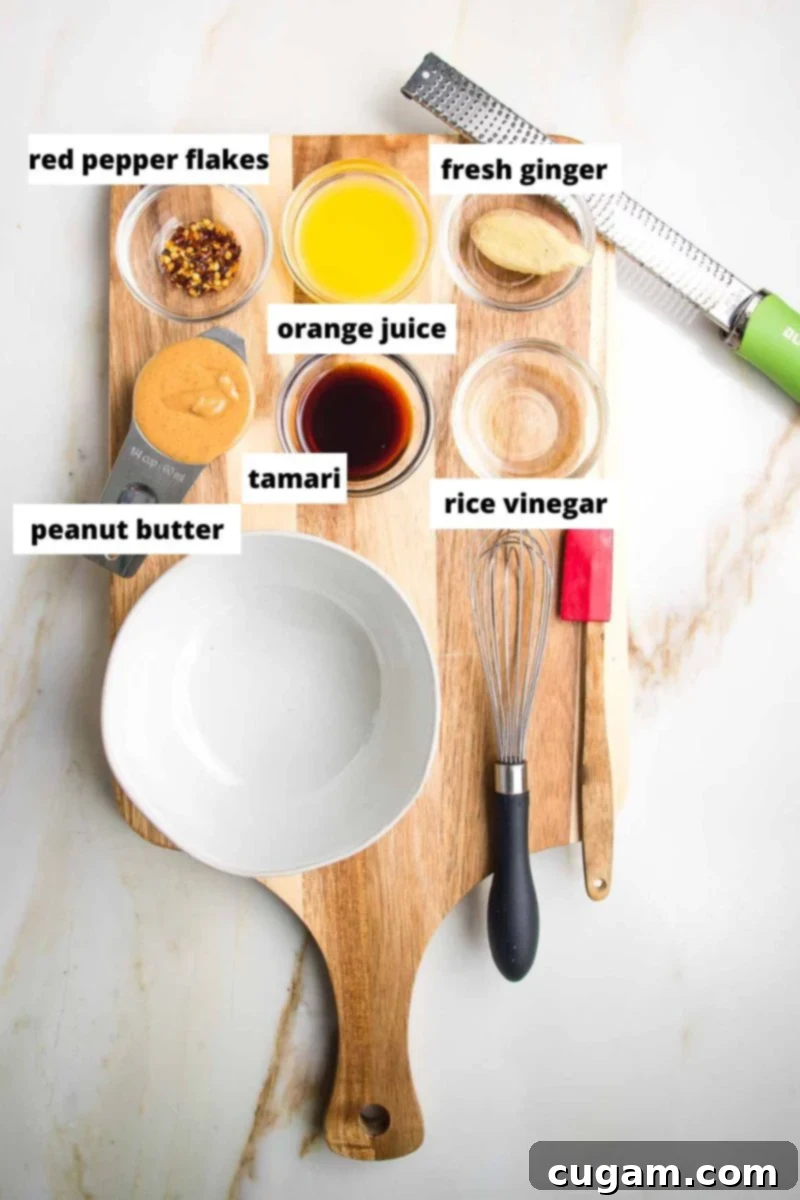
- Creamy Peanut Butter: This is, without a doubt, the star of our dipping sauce show! It provides the rich, nutty base that everyone loves. If you have a peanut allergy or simply prefer an alternative, almond butter or sunflower seed butter (SunButter) can be excellent substitutes, offering a similar creamy texture.
- Tamari: I prefer using a low-sodium, wheat-free tamari to keep the sauce gluten-free and control the saltiness. Tamari delivers that essential umami depth. Regular soy sauce can be used if gluten isn’t a concern, or for a soy-free option, coconut aminos work beautifully.
- Unseasoned Rice Vinegar: Rice vinegar adds a subtle, tangy acidity that brightens the sauce without being overpowering, unlike stronger white vinegar. Always opt for unseasoned rice vinegar to control the sweetness and flavor profile.
- Orange Juice: The natural sweetness and bright, citrusy notes from fresh orange juice provide the perfect amount of natural sweetener, balancing the savory elements of the sauce. If you prefer a slightly sweeter peanut sauce, a splash of maple syrup or honey can be added to taste.
- Fresh Ginger: Grated fresh ginger is a must-have ingredient. It imparts a wonderfully aromatic, warm, and slightly spicy flavor that elevates the sauce. Plus, fresh ginger is known for its anti-inflammatory properties, adding a healthy touch.
- Crushed Red Pepper Flakes: For those who appreciate a little warmth, a pinch of crushed red pepper flakes delivers a gentle kick. If you’re sensitive to spice, start with a tiny amount. If you love a bolder flavor, feel free to add a bit more to suit your preference.
How to Craft Your Amazing Peanut Dipping Sauce
The true secret to these incredibly delicious spring rolls lies almost entirely in the dipping sauce. Yes, it’s all about the flavor (and the fun!) that the dip brings! This is precisely why I recommend cutting your finished spring rolls in half – it allows for more surface area to dip and enjoy that sauce repeatedly. Alternatively, keep a spoon handy in the sauce bowl, so you can generously drizzle it over your rolls with every bite. This peanut sauce is so unbelievably tasty, you’ll undoubtedly want to make a double batch. Any extra can be stored in an airtight container in the fridge, ready to be repurposed as a fantastic salad dressing, a dipping sauce for crispy baked samosas or crispy baked tofu, or as the perfect excuse to make more veggie rolls!
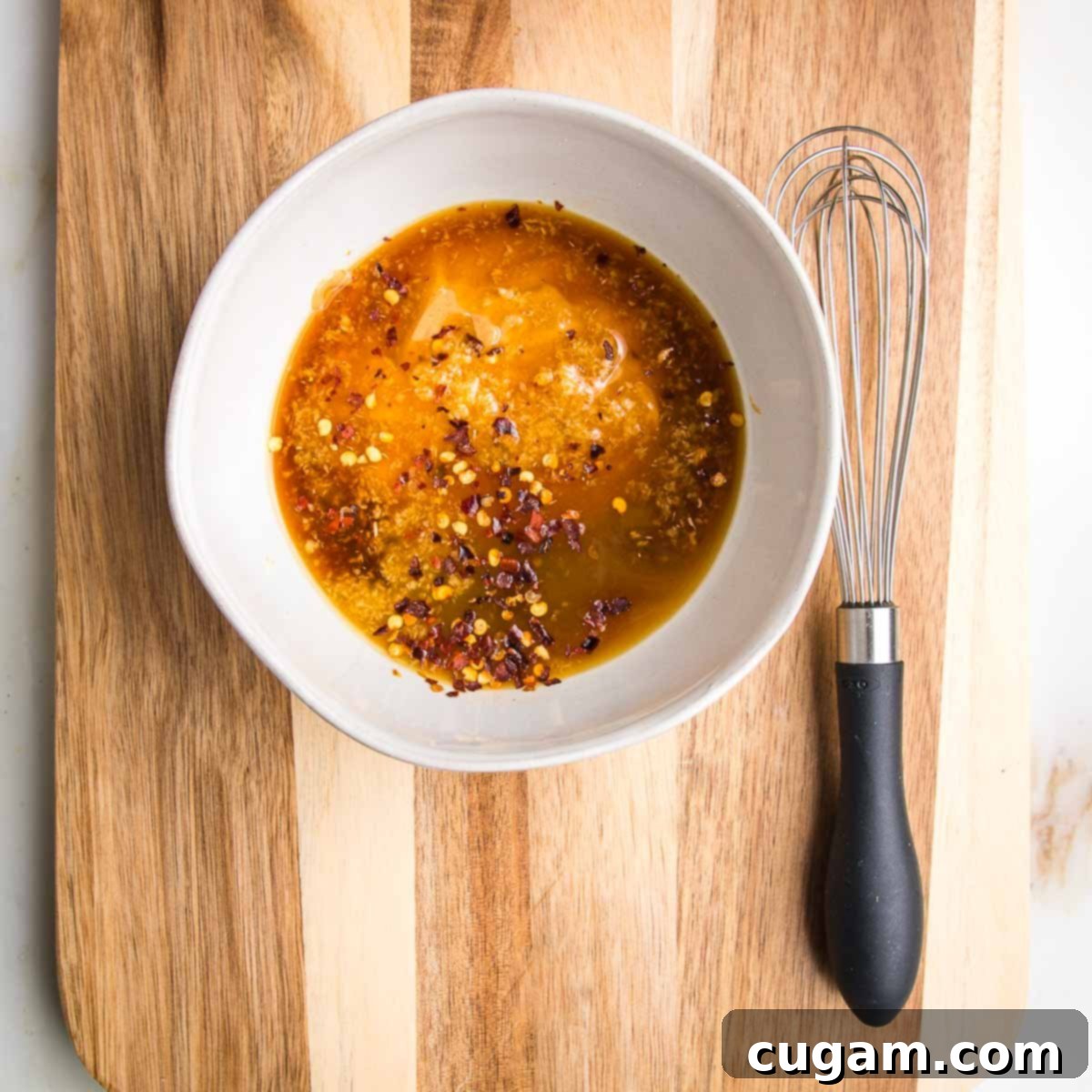
You’ll need a small mixing bowl, a trusty whisk, and a microplane grater for the ginger. Simply combine the creamy peanut butter, tamari, rice vinegar, orange juice, and crushed red pepper in your small bowl. Then, grate the fresh ginger directly over the bowl, adding its aromatic zest.
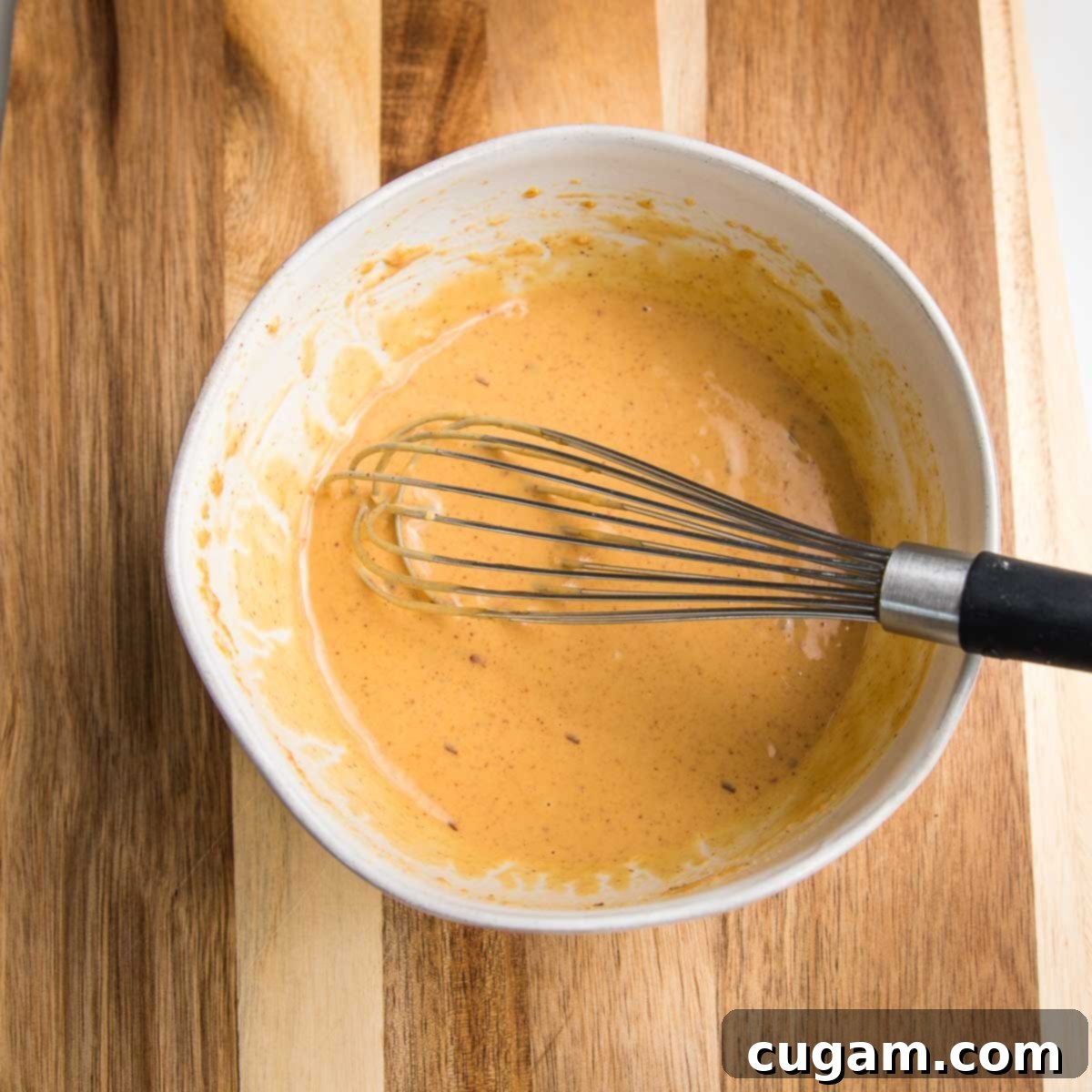
Whisk all the ingredients together vigorously until the sauce is wonderfully smooth and creamy, with no lumps of peanut butter remaining. If you find the sauce is a bit too thick for dipping, simply add 1-2 tablespoons of warm water, one tablespoon at a time, and whisk again until you reach your desired consistency. Taste and adjust seasonings as needed, perhaps adding a touch more spice or a squeeze of lime for extra brightness.

Before serving, sprinkle on some crushed peanuts for added texture and a visual flourish, along with a few more red pepper flakes if you desire an extra touch of heat.
Mastering the Art of Rolling Fresh Spring Rolls: A Step-by-Step Guide
Don’t be intimidated by the idea of rolling your own spring rolls – it’s an enjoyable and surprisingly simple process once you get the hang of it! Here’s a detailed guide to help you create perfectly packed, beautiful fresh spring rolls:
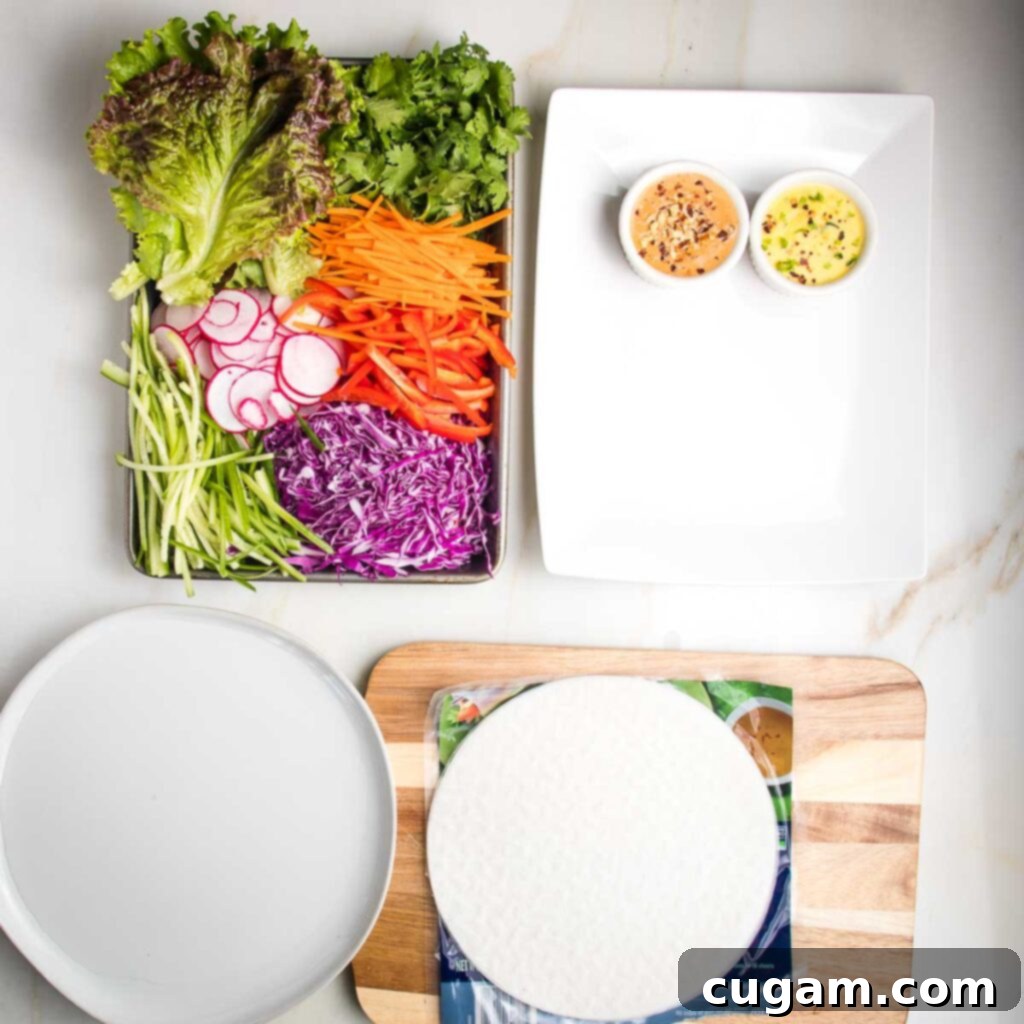
- Step 1: Prep Your Veggies (Mise en Place): This is the most important preparatory step. Ensure all your chosen vegetables are thoroughly washed, dried, and thinly sliced or julienned (cut into matchsticks). Having everything ready to go will make the rolling process smooth and efficient.
- Step 2: Prepare Your Dipping Sauce(s): While your veggies are ready, quickly whip up your chosen dipping sauce. Both the incredible peanut sauce and my zesty mango dressing are fantastic options and take mere minutes to prepare. The mango dressing is also a brilliant choice for anyone with peanut allergies. You can prep one, or offer both for a variety of flavors!
- Step 3: Set Up Your Rolling Station: Find a comfortable, clean, flat surface for rolling. Fill a large, shallow plate or a rimmed baking tray with warm water. A pie plate works particularly well for this. Keep a clean kitchen towel nearby to dry your hands or workspace as needed.
- Step 4: Soften the Rice Paper Wrapper: Carefully dip one rice paper sheet into the warm water. Submerge it completely for about 10-15 seconds, counting slowly. The goal is for the wrapper to become fully pliable and soft, but not so excessively moist that it becomes overly sticky and difficult to handle. This timing is key and might take a few tries to perfect. Once it reaches the right consistency, gently remove it and lay it flat on your clean working surface.
- Step 5: Don’t Get Frustrated: After years of practice, I’ve honed my technique and timing. It’s completely normal if your first few attempts aren’t perfectly tight or smooth. Think of them as practice rolls! You’ll quickly get a feel for the wrapper’s texture and how much filling to use.
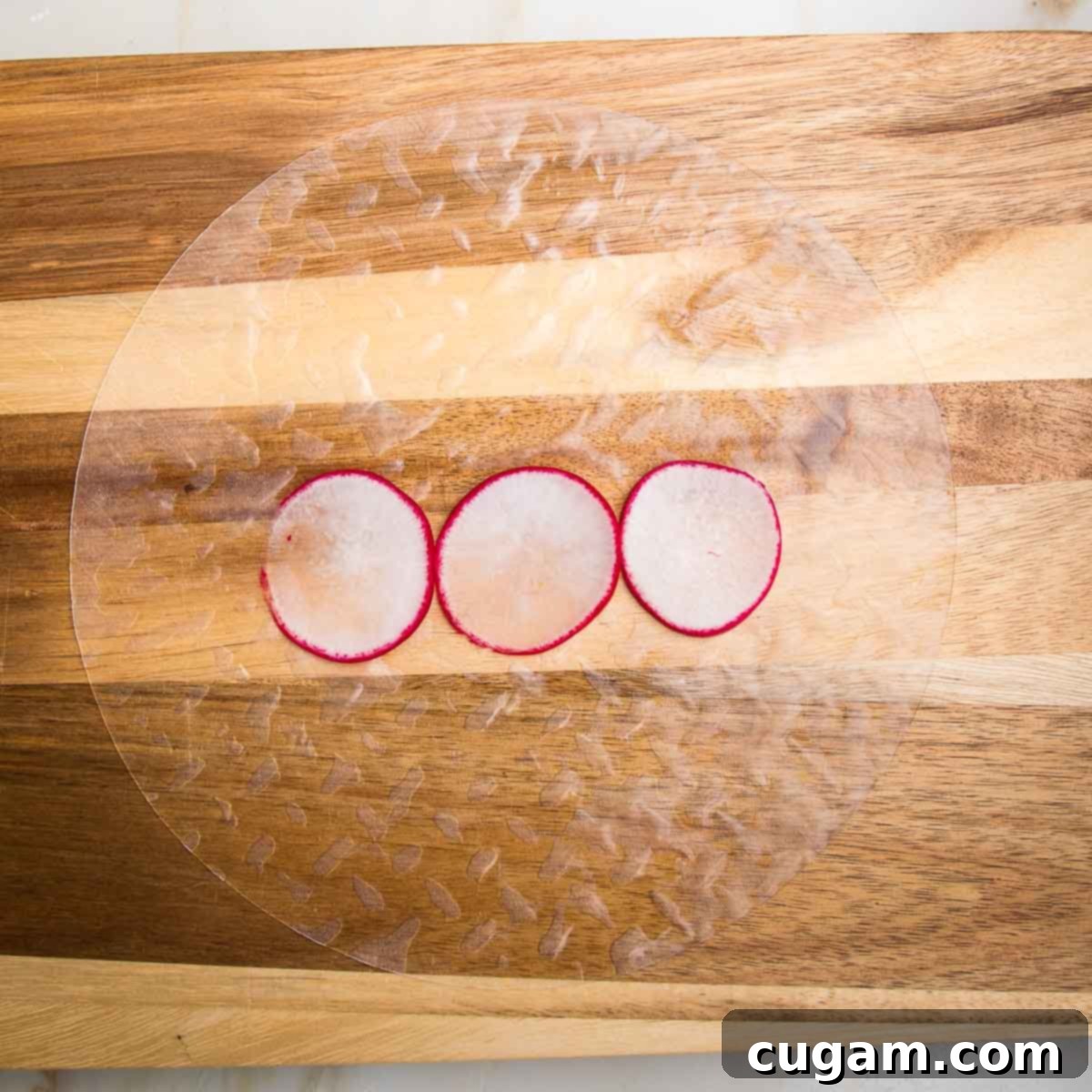
Step 6: Layer Your “Showcase” Ingredients: What you place on the bottom of the wrapper will ultimately be visible on the outside of your finished roll, creating a beautiful presentation. A row of thinly sliced, round radishes is a fantastic choice for this. If you’re using avocado, consider placing a thin slice down first, or a stack of gorgeous purple cabbage for a striking visual effect.
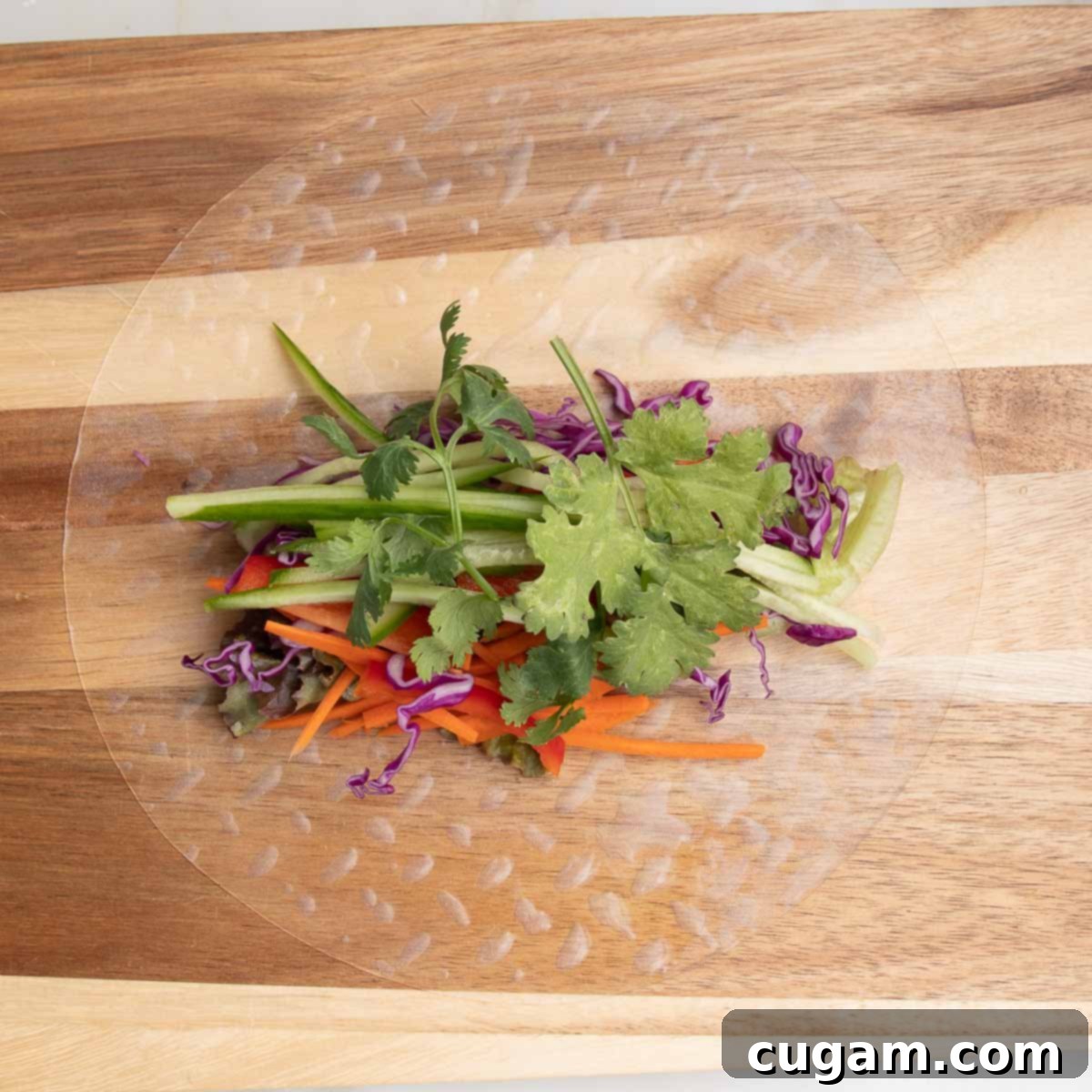
Step 7: Add the Main Filling: Arrange your remaining filling ingredients in the center of the wrapper, slightly closer to the bottom third. Don’t overfill, but create a generous pile of crunchy veggies and fresh herbs. Leave enough space on the sides for folding.
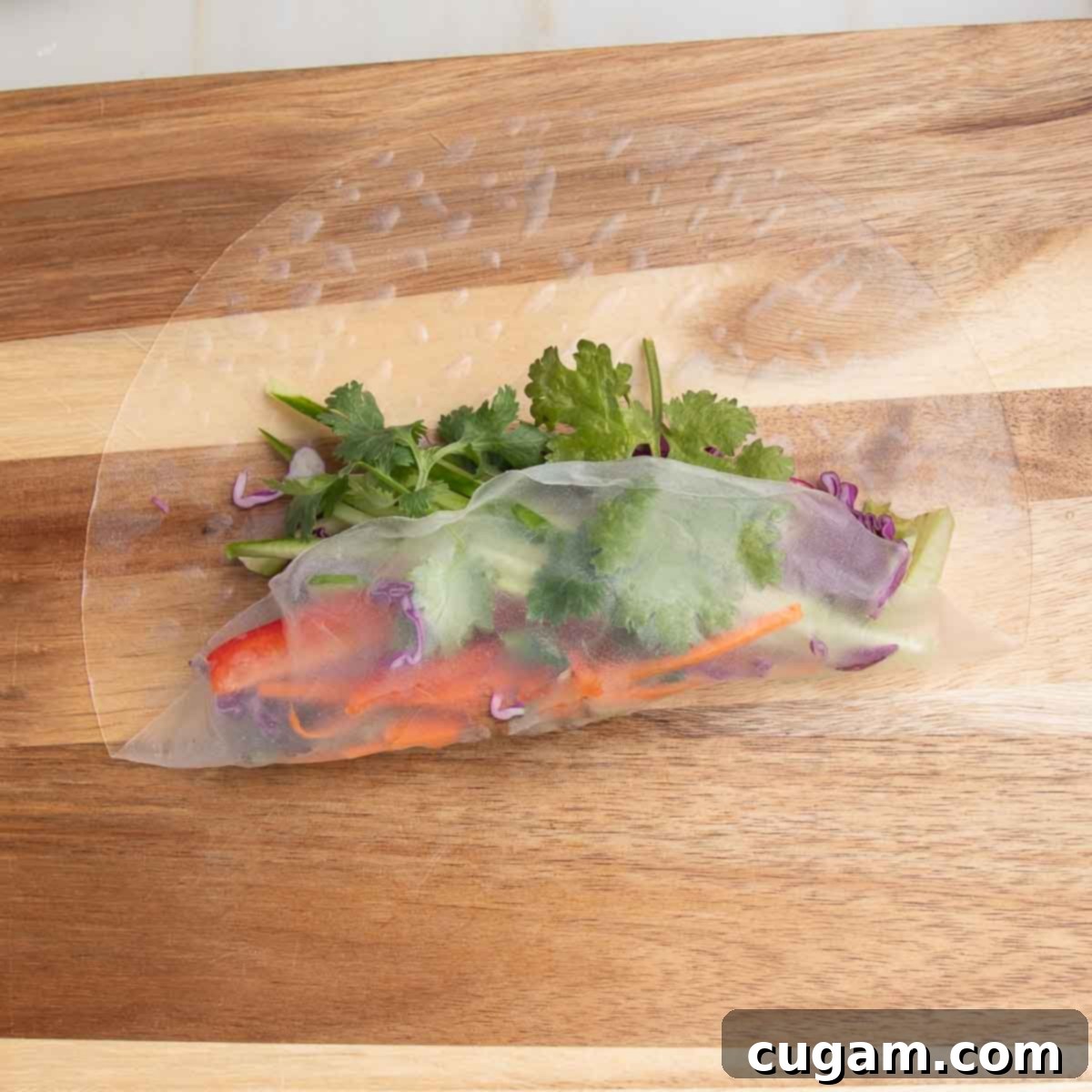
Step 8: First Fold – Bottom Up: Gently but firmly fold the bottom edge of the rice paper wrapper up over your pile of filling. Try to tuck it snugly to create a compact start to your roll.
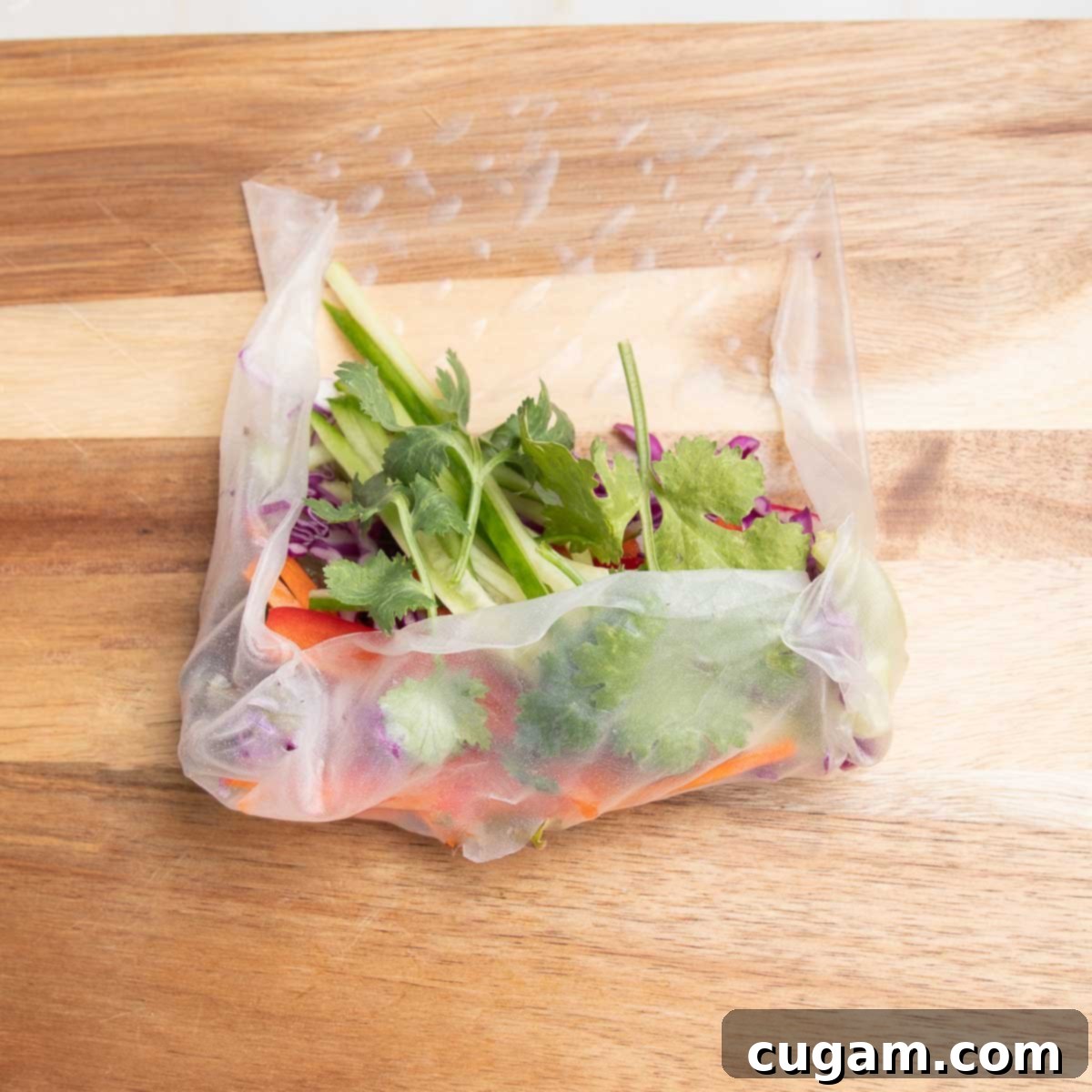
Step 9: Second Fold – Sides In: Now, fold the two side edges of the wrapper inwards over the filling. At this point, you’ll notice how the softened wrapper naturally starts to stick onto itself, creating a secure package. Aim for neat, even folds.
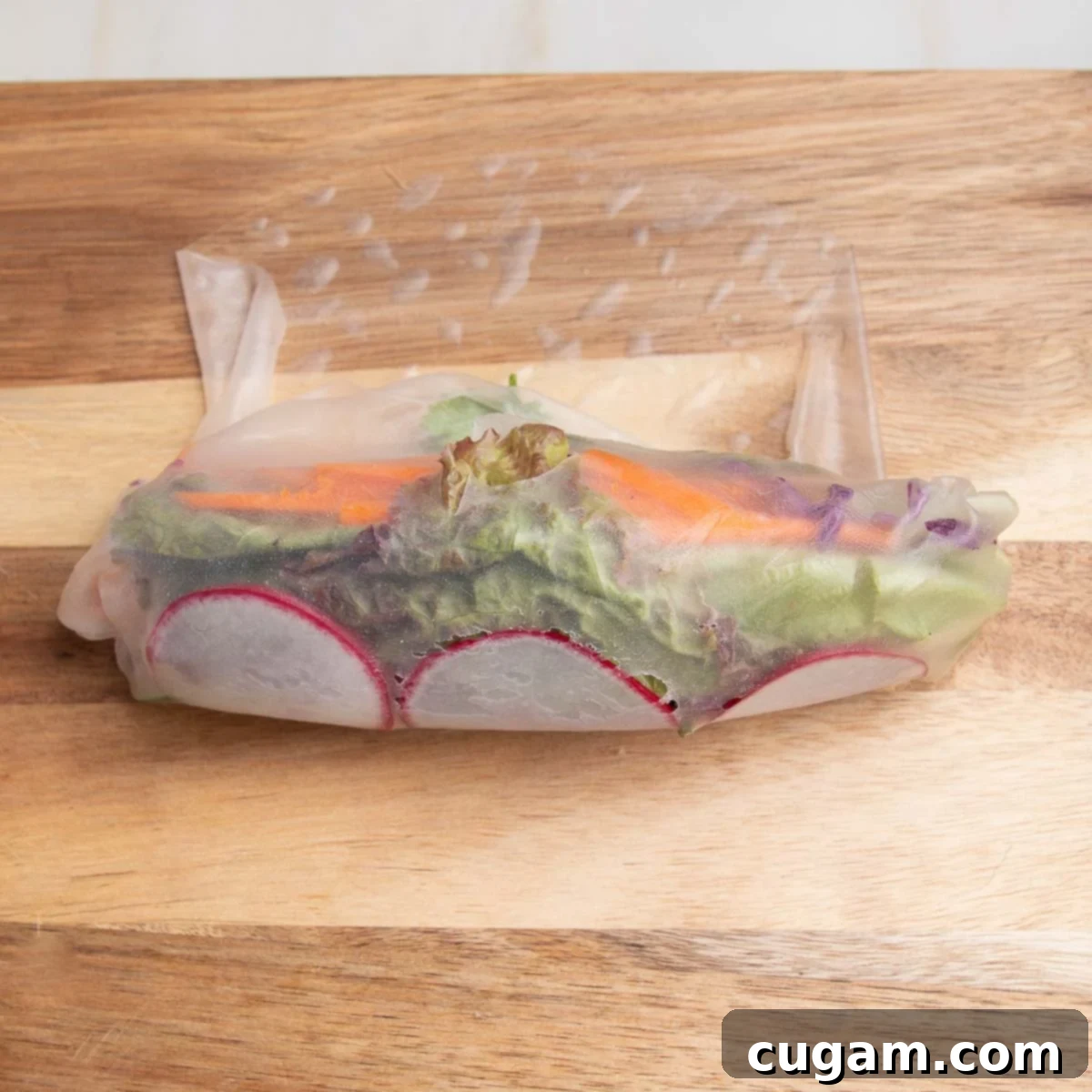
Step 10: The Final Roll: With the bottom and sides securely folded, continue to roll the entire package slowly and tightly upwards, like a burrito, until you reach the top edge. The natural stickiness of the rice paper will ensure the edges seal themselves securely. Aim for a firm, cylindrical shape.
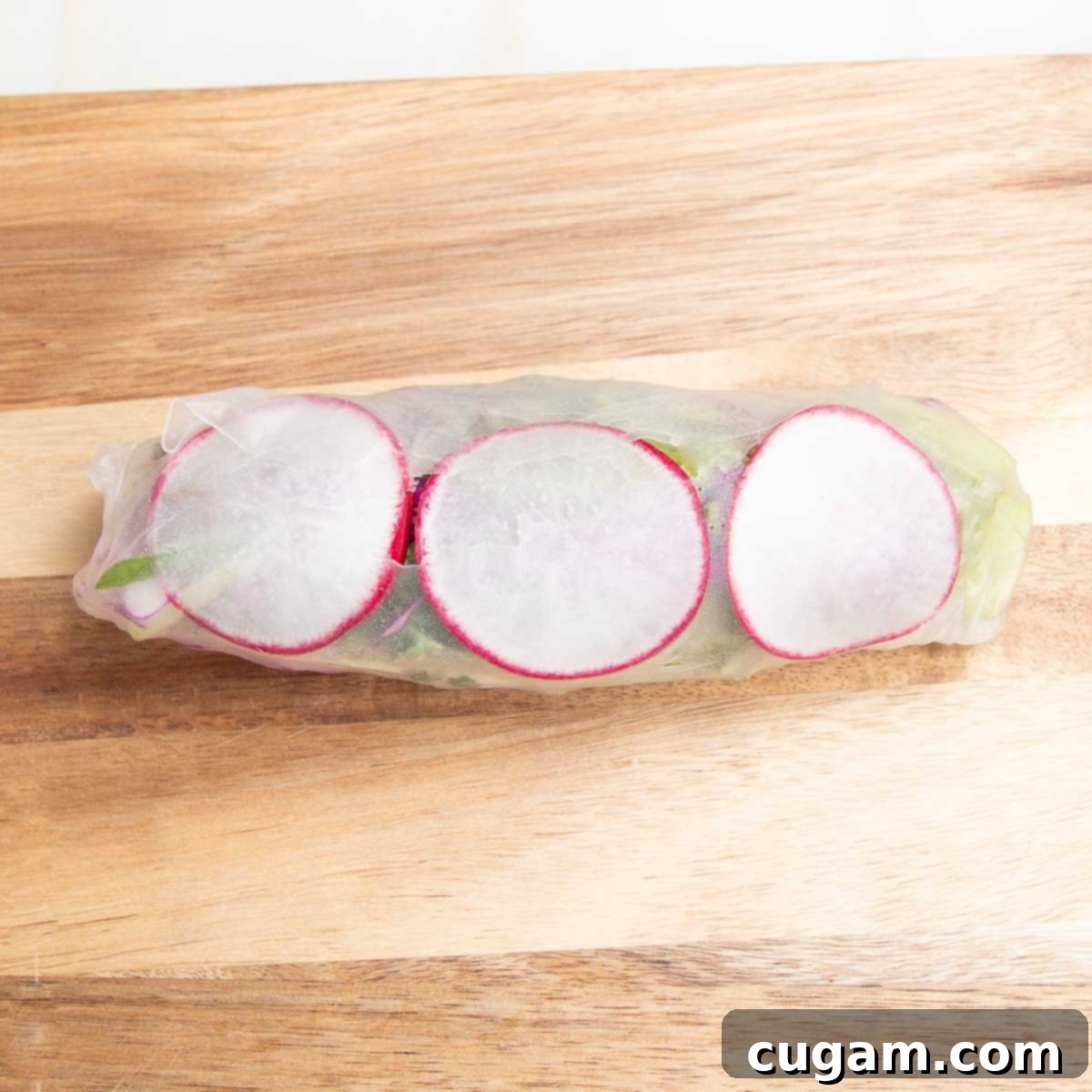
Troubleshooting: Tears and Rips: It’s perfectly normal if small holes or minor tears appear during the rolling process, especially when you’re starting out. Don’t worry! If the wrapper gets a larger rip, simply lay it onto another freshly softened rice paper sheet and re-roll it. The double layer will effectively keep the contents safely inside, and the taste will be just as delicious. No one will ever know!
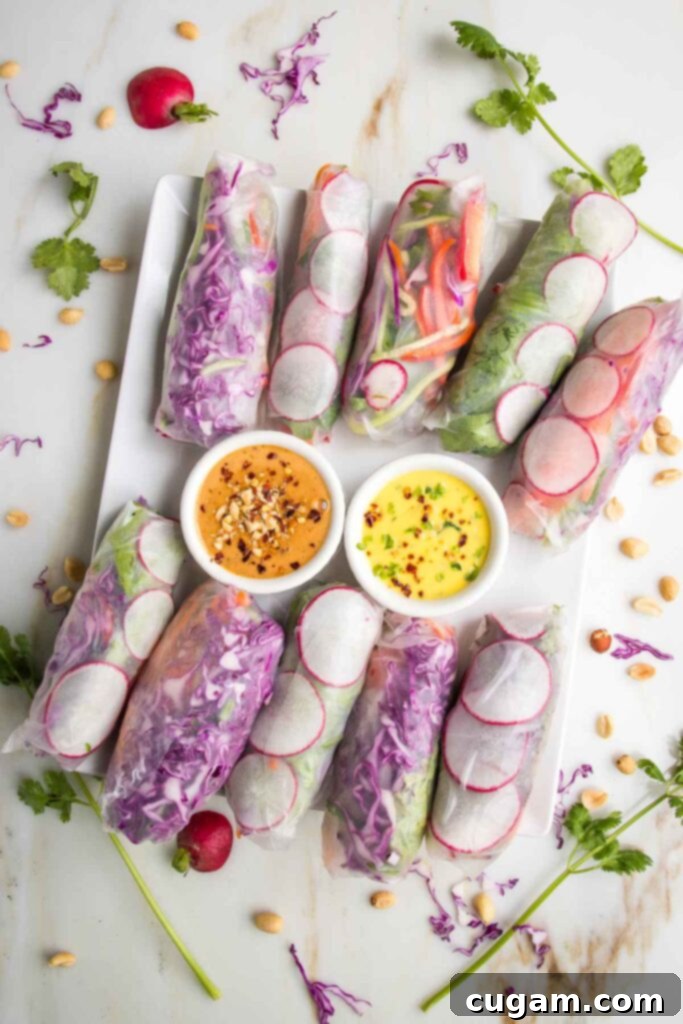
As you finish wrapping each roll, place them neatly on a serving platter. If you’ve prepared them in advance, it’s crucial to cover the rolls with a *barely* damp paper towel and then refrigerate them. This simple step prevents the delicate rice paper from drying out and becoming brittle, keeping your rolls fresh and pliable until you’re ready to serve. Serve alongside your delicious dipping sauce(s).
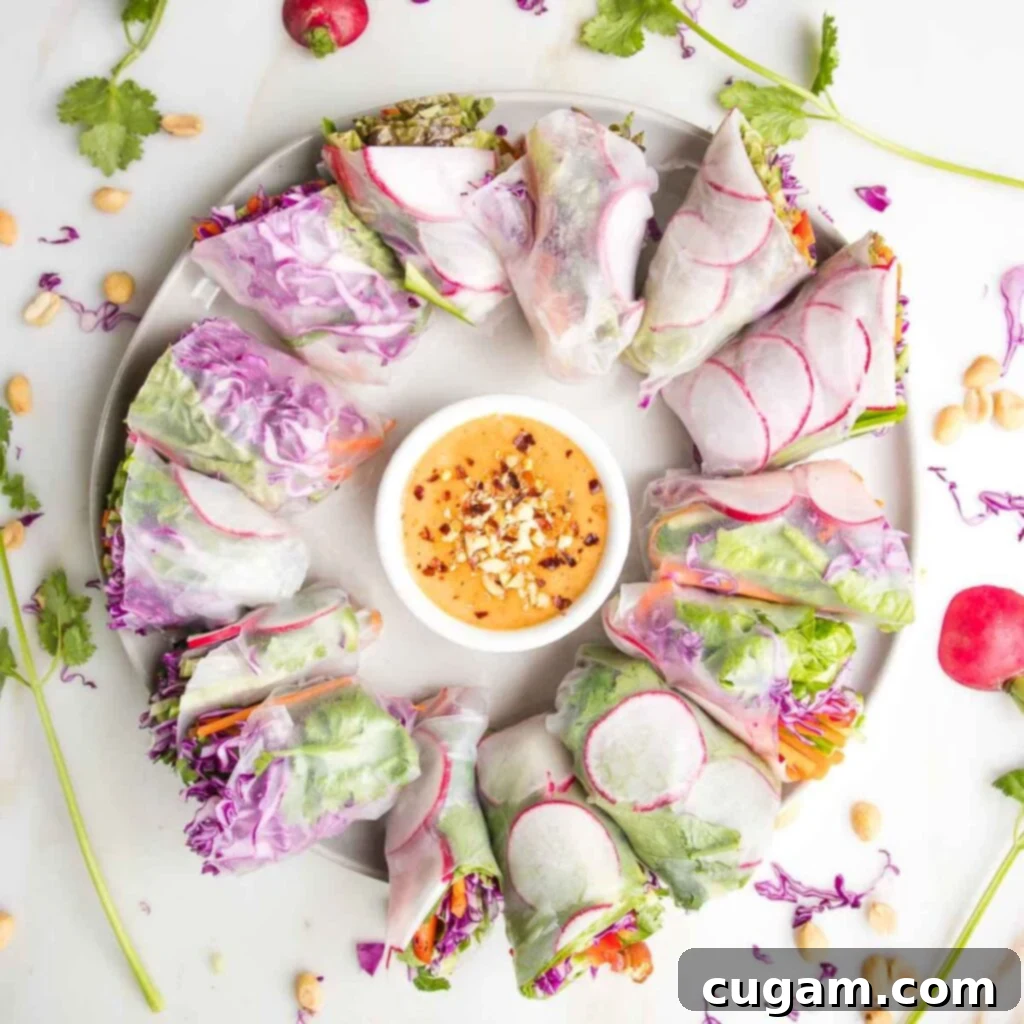
Unleash Your Creativity: What to Fill Your Fresh Rolls With
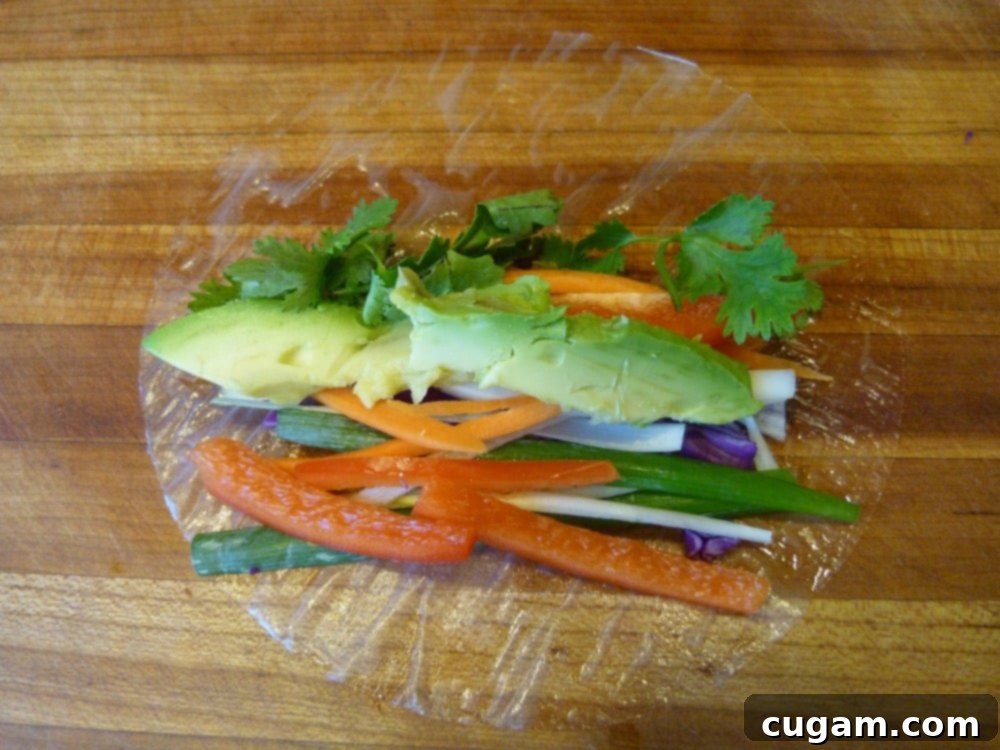
The beauty of fresh spring rolls lies in their incredible versatility. The best fillings are truly the ones you enjoy the most! Don’t feel confined to a strict list; let your imagination (and your refrigerator) be your guide.
- In this particular recipe, I’ve used a delightful combination of creamy avocado slices, crisp green onions, vibrant bell peppers, crunchy cabbage, and aromatic cilantro. This blend offers a fantastic balance of flavors and textures.
- Remember, your veggie fillings don’t have to be perfectly julienned every single time. While matchsticks make for easier rolling, some rustic charm is perfectly acceptable! Feel free to cut them into strips, use pre-shredded carrots from the grocery store, or coarsely rip lettuce leaves and fresh herbs. Whatever streamlines your prep and gets you ready to roll quickly is absolutely great.
- Beyond the core ingredients, consider adding other protein-rich elements like thinly sliced grilled tofu or tempeh, cooked shrimp, or even leftover shredded chicken for a non-vegan option. Fresh mint leaves and Thai basil add an authentic aromatic touch. For a more substantial roll, you can incorporate cooked rice vermicelli noodles.
- Seasonal vegetables are always a fantastic choice. In spring, think asparagus spears or snap peas. In summer, corn kernels or ripe tomatoes can add sweetness. Don’t be afraid to experiment!
Choosing the Right Spring Roll Wrappers: A Guide
The foundation of a great fresh spring roll is its wrapper. Spring roll wrappers, often referred to as rice paper wrappers, typically come in two common sizes: 7 or 9 inches in diameter. When purchasing, look for wrappers with simple, straightforward ingredients. Rice flour should ideally be the very first ingredient listed, indicating a high-quality wrapper. They may also contain a small amount of cassava flour or tapioca starch, which helps with pliability, and this is perfectly fine.
For the widest selection and best prices, your local Asian market is an excellent place to find various brands and types of fresh Vietnamese spring roll wrappers. However, you can also readily find them in most local grocery stores, usually located in the ethnic foods or international aisle.
The size you choose depends on your intended serving style. Opt for larger rice paper sheets (like 9-inch) if you want to make full-size rolls that can easily serve as a satisfying main course. Once wrapped, these larger rolls can be cut in half crosswise, creating perfect bite-sized appetizers that are easier to dip and enjoy. Alternatively, if you’re aiming for a healthier appetizer or a delicate snack, choose the smaller rice wrappers (7-inch) and serve them whole. Both sizes work beautifully; it’s simply a matter of preference and portion control.
Debra’s Pro Tips for Perfect Spring Rolls
Honing your spring roll making skills is easy with a few insider tricks. Here are my top tips to ensure your fresh spring rolls turn out perfectly every time:
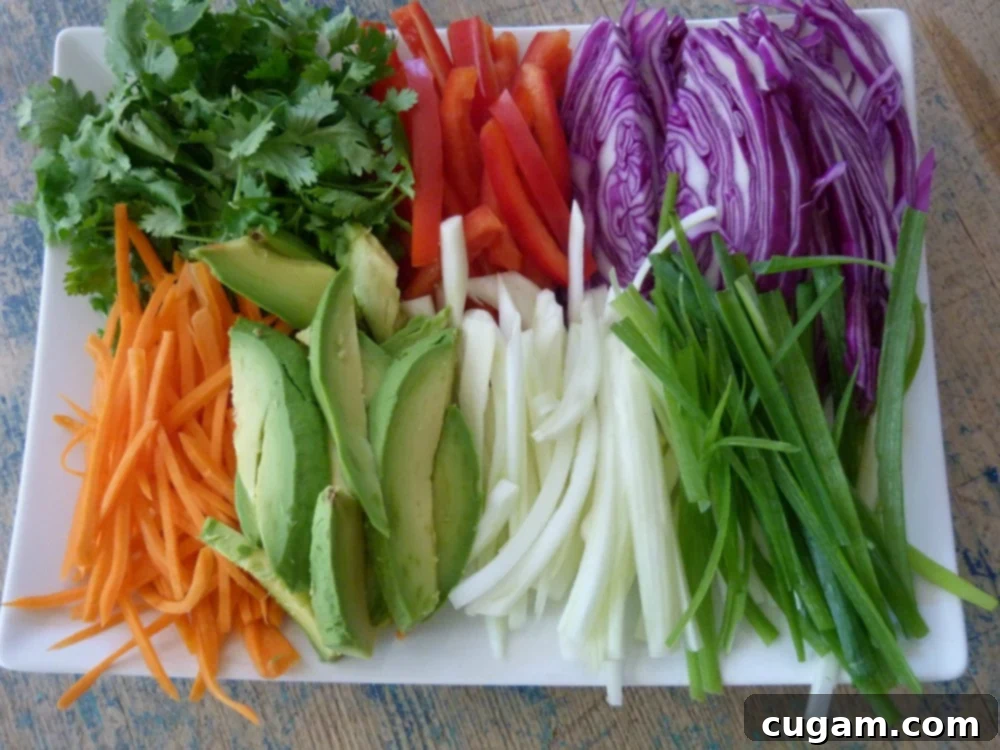
- Seasonal Variety is Key: Don’t limit yourself to the same veggies! Vary your filling ingredients based on what’s fresh and in season. This keeps your spring rolls exciting and ensures the best flavor.
- Embrace Mise en Place: This cannot be stressed enough. Whether you spend a few hours prepping ingredients in advance or just a few minutes before you’re ready to roll, having all your components washed, chopped, and organized will eliminate stress and make the process truly enjoyable.
- Keep Rolls Moist: To prevent your freshly rolled spring rolls from drying out and becoming brittle, cover them with a *barely* damp paper towel immediately after rolling. Then, refrigerate them until you’re ready to serve. Avoid overly wet towels, as they can make the wrappers soggy.
- Choose Your Wrapper Size Wisely: Use larger rice paper wrappers (e.g., 9-inch) if you intend to serve the rolls as a main course or want the flexibility to cut them in half for appetizers. Smaller wrappers (e.g., 7-inch) are perfect for bite-sized, healthy appetizers served whole.
- Revive Thickened Sauce: If your homemade peanut dipping sauce has been refrigerated and thickened too much, simply whisk in 1-2 tablespoons of warm water until it returns to a perfectly pourable consistency.
- Practice Makes Perfect: Don’t get discouraged if your first few attempts at rolling aren’t perfectly smooth or cylindrical. It takes a little practice to figure out the ideal soaking time for the rice paper sheets and the right amount of filling. Be patient, and you’ll quickly master the technique!
- No Waste Leftovers: When you’re done rolling, gather all the leftover prepped veggies and store them in an airtight container in the fridge. This makes an excellent, ready-to-go base for your next quick salad, ensuring no delicious produce goes to waste.
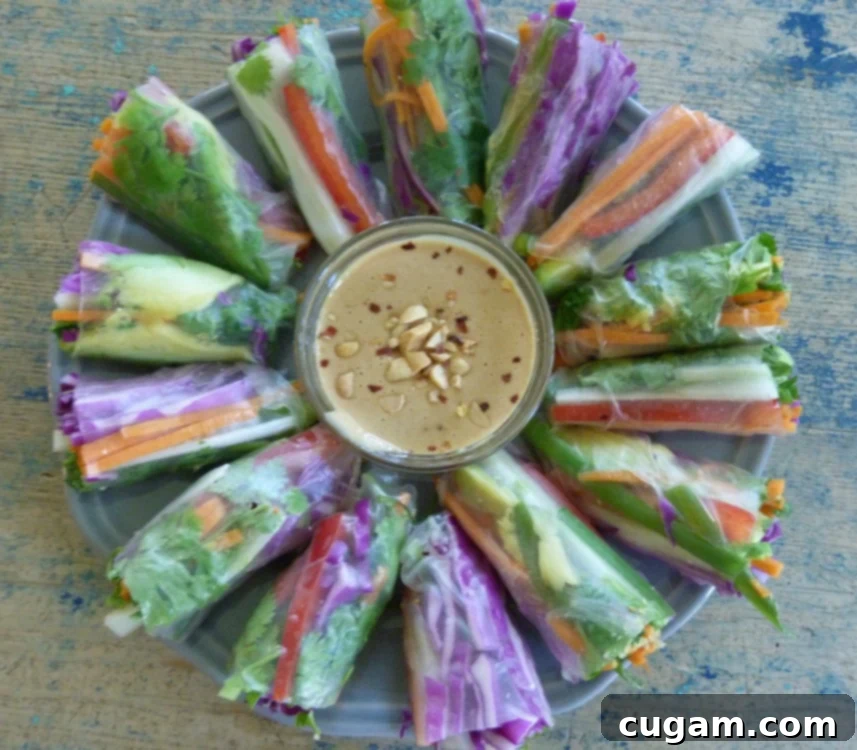
Storage and Make-Ahead Tips
Fresh spring rolls are best enjoyed shortly after they are made to fully appreciate their delicate texture and crisp fillings. However, they can be prepared a few hours in advance if needed for entertaining.
- Immediate Serving: If serving immediately, arrange them on a platter and cover them with a barely damp paper towel to prevent drying.
- Make-Ahead (Short Term): For preparation up to 2-3 hours in advance, follow the damp paper towel method and then cover the entire platter tightly with plastic wrap. Refrigerate until ready to serve. The rice paper can start to firm up or become too sticky if stored for too long, so aim for same-day consumption.
- Dipping Sauce Storage: The peanut dipping sauce can be made several days in advance and stored in an airtight container in the refrigerator. If it thickens, simply whisk in a tablespoon or two of warm water until it reaches your desired consistency.
- Leftover Fillings: Any remaining prepped vegetables can be stored in an airtight container for 2-3 days in the fridge, perfect for quick salads or stir-fries.
- Freezing: Fresh spring rolls do not freeze well, as the rice paper wrappers and fresh vegetables will become mushy upon thawing. It’s always best to enjoy them fresh!
Customization and Variations for Endless Flavor
One of the most exciting aspects of making fresh spring rolls is the opportunity for endless customization. Beyond the vegetables, consider these variations to keep things exciting:
- Protein Power: Add cooked and cooled rice vermicelli noodles for a more substantial roll. For protein, include thinly sliced grilled or baked tofu, marinated tempeh, or even cooked and chilled shrimp (for non-vegan versions).
- Herbacious Twist: Experiment with different fresh herbs. Besides cilantro, try mint, Thai basil, or even a hint of arugula for a peppery kick.
- Fruity Notes: Slices of mango or pineapple can add a delightful sweetness and tropical flair, especially when paired with the mango dressing.
- Crunch Factor: Boost the crunch with water chestnuts, jicama, or different types of sprouts like alfalfa or mung bean.
- Flavor Boosters: A thin smear of hummus, a touch of sriracha mayo (for those who like spice), or even a sprinkle of toasted sesame seeds inside the roll can elevate the flavor profile.
- Sweet & Savory Sauces: While the peanut sauce is divine, explore other dipping options like sweet chili sauce, hoisin sauce, or a simple lime-soy vinaigrette. My mango dressing is also a fantastic, fruity alternative.
Frequently Asked Questions (FAQ) About Spring Rolls
Got questions? We’ve got answers to help you master these delicious fresh spring rolls.
- What is the difference between spring rolls and summer rolls?
Generally, “spring rolls” can refer to both fresh (uncooked) and fried varieties, while “summer rolls” almost exclusively refers to the fresh, uncooked rolls wrapped in rice paper. In Vietnamese cuisine, these fresh rolls are often called Gỏi Cuốn. This recipe focuses on the fresh, uncooked version. - Are these spring rolls healthy?
Absolutely! These vegetable spring rolls are packed with fresh, raw vegetables, making them rich in vitamins, minerals, and fiber. The rice paper wrappers are light, and the homemade peanut sauce, made with wholesome ingredients, offers healthy fats and protein. They are a fantastic, low-calorie, nutrient-dense meal or snack. - Can I make these ahead of time for a party?
While best enjoyed fresh, you can prepare them 2-3 hours in advance. To prevent them from drying out, place them on a platter, cover them with a *barely* damp paper towel, and then wrap the entire platter tightly with plastic wrap before refrigerating. For longer storage, it’s better to prep the fillings and sauce separately and assemble just before serving. - My rice paper wrappers are too sticky or tearing. What am I doing wrong?
This is a common issue! The key is the soaking time. If they are too sticky, you might be soaking them for too long. If they’re tearing, they might be too wet or you’re overfilling them. Aim for 10-15 seconds in warm (not hot) water until pliable but still slightly firm. Also, don’t overstuff your rolls. If a wrapper tears significantly, simply use a second wrapper to double-wrap the roll – it will still taste delicious!
Did you know commenting and rating recipes is one of the best ways to support your favorite food bloggers? If you made this delicious Veggie Spring Rolls with Peanut Sauce recipe, please consider leaving a five-star rating below and a comment sharing your experience. Also, we’d love to see your creations! Please share your photos on Instagram by tagging me @dkhealthcoach and using the hashtag #debraklein or #dkhealthcoach. Your support means the world!
📖 Recipe
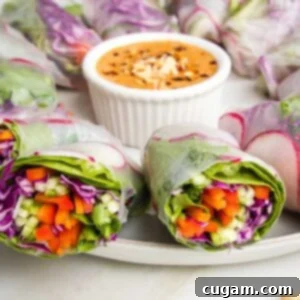
Veggie Spring Rolls with Peanut Sauce
Debra Klein
Rate this Recipe
Pin Recipe
15
minutes
15
minutes
12
rolls
56
kcal
Ingredients
-
1
bunch red radish
thinly sliced into rounds -
12
lettuce leaves -
¼
head red cabbage
shredded -
1
large carrot
cut into matchsticks -
1
red bell pepper
thinly sliced -
2
persian cucumbers
thinly sliced lengthwise -
1
bunch fresh cilantro -
12
8-inch rice paper wrappers
Peanut Dipping Sauce
-
¼
cup
creamy peanut butter -
2
Tablespoons
orange juice -
1
Tablespoon
unseasoned rice vinegar -
1
Tablespoon
low sodium tamari* -
1
Tablespoon
maple syrup -
1
teaspoon
grated fresh ginger -
¼
teaspoon
crushed red pepper
Instructions
-
MAKE PEANUT DIPPING SAUCE: Add all sauce ingredients (peanut butter, orange juice, rice vinegar, tamari, maple syrup, grated fresh ginger, and crushed red pepper) to a small bowl. Use a whisk to combine until completely smooth and creamy. If the dipping sauce appears too thick, gradually add 1-2 tablespoons of warm water, whisking after each addition, until you reach your desired consistency. Taste the sauce for seasoning and adjust as needed, perhaps adding more crushed red pepper for spice or a splash of lime juice for brightness.
-
PREPARE VEGGIES: Thoroughly wash and dry all vegetables. Thinly slice the red radishes into small rounds. Shred or thinly slice the red cabbage. Cut the large carrot into slender matchsticks. Thinly slice the red bell pepper into strips. Julienne (thinly slice lengthwise) the Persian cucumbers. Wash and gently dry the lettuce leaves and fresh cilantro. Arrange all prepped veggies on a platter for easy access (mise en place).
-
SET UP ROLLING STATION: Prepare a shallow dish (like a pie plate or a large, rimmed plate) with warm (not hot) water. This will be used to soften the rice paper sheets for rolling. Keep a clean kitchen towel nearby to dry your hands or your work surface if it gets wet or sticky during the process.
-
SOFTEN RICE PAPER: Dip one piece of rice paper round into the warm water. Submerge it completely for about 10-15 seconds, or until it becomes soft and translucent. It should be pliable but not overly sticky. Remove the softened wrapper and lay it flat on a clean, dry surface to begin filling and rolling.
-
FILL THE WRAPPER: Place your chosen filling ingredients in the lower half of the softened wrapper, leaving space around the edges for folding. For a beautiful presentation, start with a neat row of radish rounds. Then, add a lettuce leaf, followed by a portion of shredded cabbage, carrots, bell peppers, cucumbers, and a sprig of fresh cilantro. Do not overfill.
-
ROLL THE SPRING ROLL: First, fold the bottom edge of the rice paper wrapper up over the filling, tucking it snugly. Next, fold in the two side edges. Finally, continue to roll the entire package tightly and slowly upwards, like a burrito, until you reach the top edge. The natural stickiness of the rice paper will help it seal securely. Set each finished roll onto a serving plate. Immediately cover the rolled spring rolls with a *barely* damp towel to keep them moist and prevent drying out.
-
SERVE OR STORE: You can serve the spring rolls immediately with the peanut dipping sauce. If preparing them in advance, cover the platter tightly with plastic wrap over the damp towel and place it in the fridge until ready to serve (ideally within 2-3 hours).
-
GARNISH SAUCE: Fill a small bowl with the prepared peanut dipping sauce. If desired, sprinkle with crushed peanuts and additional red pepper flakes for extra flavor and texture.
Notes
FOR HOLES WHILE ROLLING: If one of your rolls tears or develops a large hole, don’t worry! It’s perfectly fine to double-wrap it by placing the torn roll onto another freshly softened rice paper sheet and rolling it again. This will secure the contents, and the roll will still be delicious.
OPTIONAL FILLING INGREDIENTS: Feel free to customize your spring rolls with a variety of other delicious fillings. Consider adding green onions, creamy avocado slices, cooked rice noodles or rice vermicelli, crisp bean sprouts, aromatic fresh mint, fragrant Thai basil, fresh parsley, a handful of peppery arugula, or any other fresh vegetables you love!
SPRING ROLL WRAPPERS: When purchasing, look for rice paper wrappers that predominantly feature rice flour and water in their ingredient list. They may also contain cassava flour or tapioca flour, which helps with their pliability and is acceptable, but rice flour should always be the primary ingredient. Rice paper sheets are available in various sizes; you can buy smaller ones to serve whole as appetizers, or use larger rice wrappers and cut them in half *after* you have rolled them, for a perfect appetizer portion.
PEANUT SAUCE VARIATIONS: For a more savory peanut sauce, consider adding 1 teaspoon of fresh lime juice and 2 teaspoons of toasted sesame oil to the mixture. If you prefer a sweeter spring rolls sauce, you can either try my refreshing mango dressing (linked above) or enhance the peanut sauce with an additional 1 teaspoon of maple syrup.
TAMARI SUBSTITUTIONS: Tamari is a popular gluten-free alternative to traditional soy sauce. If you don’t require a gluten-free option, you can easily substitute with regular soy sauce. For those seeking a soy-free option, coconut aminos work very well. Regardless of your choice, I always recommend buying the low-sodium variety to better control the overall saltiness of the sauce.
Nutrition
Serving:
2
rolls
Calories:
56
kcal
Carbohydrates:
7
g
Protein:
2
g
Fat:
3
g
Saturated Fat:
1
g
Polyunsaturated Fat:
2
g
Sodium:
80
mg
Fiber:
2
g
Sugar:
3
g
Note
The nutrition calculations provided were estimated using online tools. To obtain the most accurate representation of the nutritional information for any given recipe, you should calculate it with the actual ingredients and brands you use. You are ultimately responsible for ensuring that any nutritional information you rely upon is accurate, complete, and useful for your specific dietary needs.
Did you make this recipe?
Please leave a review below, then snap a picture and tag me @dkhealthcoach or use hashtag #dkhealtcoach on Instagram so I can see it!!
